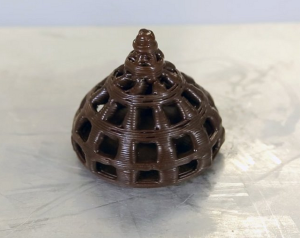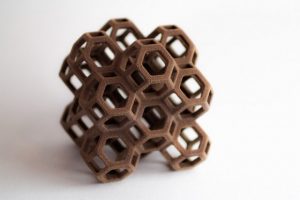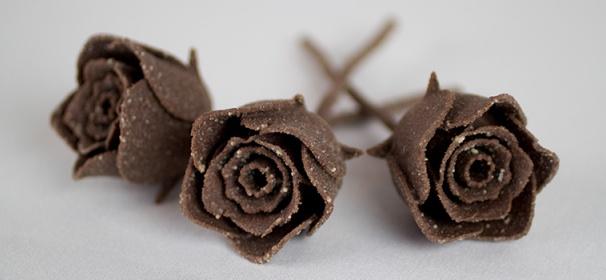Whenever we say chocolate, we immediately start wanting to eat some. Chocolate has been around for quite a long time, in fact, it is said it has been around since 350 B.C. as cacao beverages or chocolate drinks. And when we thought that the chocolate industry reached its peak, the 3D printing era made sure to take chocolate to a whole new level.
Additive manufacturing has reached many food markets so it is no surprise that 3D printing made its impact on the chocolate industry. Companies such as Hershey, Nestlé, Mars Inc., and Mondelez International had been experimenting with 3D printed chocolate for the last few years, and 3D printing brings creativeness and innovation to the industry.
It is clear that taste is not enough to attract chocolatiers, and that design is now becoming an important aspect in the industry. In order to seduce customers, 3D models can be turned into an edible chocolate creations.
So, how does it work?
 The majority of chocolate 3D printers work with CAD files, just like as a normal 3D printer. Instead of a filament, the chocolate 3D printers use a syringe, which is loaded and then it keeps the chocolate at temperature as it prints. The extruder head moves around and lays down the melted chocolate with the shape desired in layers. The chocolate eventually cools and becomes solid. The syringe loading system is food-safe, clean, efficient, and keeps the chocolate fresh. If the operating temperatures are followed, the chocolate shouldn’t dry up in the syringe at all.
The majority of chocolate 3D printers work with CAD files, just like as a normal 3D printer. Instead of a filament, the chocolate 3D printers use a syringe, which is loaded and then it keeps the chocolate at temperature as it prints. The extruder head moves around and lays down the melted chocolate with the shape desired in layers. The chocolate eventually cools and becomes solid. The syringe loading system is food-safe, clean, efficient, and keeps the chocolate fresh. If the operating temperatures are followed, the chocolate shouldn’t dry up in the syringe at all.
Why is it harder to print?
 It is easier to print plastic than to print chocolate. Chocolate has very different melting and cooling properties than plastic, thus melted chocolate can’t harden as fast. This could lead to 3D printed chocolate losing its shape due to the temperature and gravity. The type of chocolate is also important. Whether it’s milk, dark or white chocolate, they all have different viscosities, for it is recommended to use a high-quality and machine-tempered chocolate like Belgian dark chocolate. If not then one has to temper the chocolate on the device. In some cases people have added significant amounts of pectin to try to make 3D printing easier as well. Since chocolate can’t be rolled into a hard filament because the texture is too soft, the melted chocolate is stored in a cartridge and extruded with a syringe. Belgian chocolate has mostly shown better printing results compared to other types of chocolate since it has higher levels of cocoa solids.
It is easier to print plastic than to print chocolate. Chocolate has very different melting and cooling properties than plastic, thus melted chocolate can’t harden as fast. This could lead to 3D printed chocolate losing its shape due to the temperature and gravity. The type of chocolate is also important. Whether it’s milk, dark or white chocolate, they all have different viscosities, for it is recommended to use a high-quality and machine-tempered chocolate like Belgian dark chocolate. If not then one has to temper the chocolate on the device. In some cases people have added significant amounts of pectin to try to make 3D printing easier as well. Since chocolate can’t be rolled into a hard filament because the texture is too soft, the melted chocolate is stored in a cartridge and extruded with a syringe. Belgian chocolate has mostly shown better printing results compared to other types of chocolate since it has higher levels of cocoa solids.
What are the limitations of 3D printing chocolate?
 Chocolate 3D printers haven’t been around for very long, so the chocolate industry has yet to expand and learn what more could be done with 3D printers. Chocolate 3D printers aren’t suitable for mass production but it is perfect for those who want to try them out, customize chocolate, or just design new shapes. The main problem with chocolate 3D printers is the temperature. The process can be time-consuming and this is due to temperature complications. The chocolate has to be heated enough to melt and at the same time it must be cool and dry enough to maintain its shape.
Chocolate 3D printers haven’t been around for very long, so the chocolate industry has yet to expand and learn what more could be done with 3D printers. Chocolate 3D printers aren’t suitable for mass production but it is perfect for those who want to try them out, customize chocolate, or just design new shapes. The main problem with chocolate 3D printers is the temperature. The process can be time-consuming and this is due to temperature complications. The chocolate has to be heated enough to melt and at the same time it must be cool and dry enough to maintain its shape.
And the main benefits?
 Apart from being chocolate and us being able to eat it, chocolate 3D printers let us customize shapes and forms perhaps making individual bonbons or topical sweets for events. 3D printing, in general, is already about ultra-personalization. Anyone can enjoy complex 3D designs that would be impossible to do it with our own hands. Sculpting and molding is a bit limited and chocolate 3D printers help us expand our ideas.
Apart from being chocolate and us being able to eat it, chocolate 3D printers let us customize shapes and forms perhaps making individual bonbons or topical sweets for events. 3D printing, in general, is already about ultra-personalization. Anyone can enjoy complex 3D designs that would be impossible to do it with our own hands. Sculpting and molding is a bit limited and chocolate 3D printers help us expand our ideas.
It is always recommended to use models that aren’t too large, that have areas of fine detail, or unsupported overhand or angles that are too steep. In the said case, the model will have to be edited. To print complex models, reduce the printing speed so the chocolate has more time to dry and harden and the next layer can be built.
The chocolate industry has yet to expand in the world of 3D printing. The temperature, time, and process are the three main issues that must be solved in order to make the production more efficient. In the meantime, we can still enjoy chocolate with traditional or new and 3D printed designs. Maybe it’s time I get myself a chocolate 3D printer!
Subscribe to Our Email Newsletter
Stay up-to-date on all the latest news from the 3D printing industry and receive information and offers from third party vendors.
You May Also Like
3D Printing News Briefs, April 13, 2024: Robotics, Orthotics, & Hypersonics
In 3D Printing News Briefs today, we’re focusing first on robotics, as Carnegie Mellon University’s new Robotics Innovation Center will house several community outreach programs, and Ugogo3D is now working...
Rail Giant Alstom Saves $15M with 3D Printing Automation Software 3D Spark
3D Spark has entered into a three-year deal with the rail giant Alstom. Alstom, a transport behemoth with annual revenues of $16 billion, specializes in the manufacture of trains, trams,...
Meltio Expands Global Reach with New Partnerships in the Americas and Europe
Spanish 3D printing manufacturer Meltio has expanded its sales network across the globe. With the addition of three new partners in the United States, Brazil, Argentina, and Italy, Meltio aims...
3D Printing Webinar and Event Roundup: April 7, 2024
Webinars and events in the 3D printing industry are picking back up this week! Sea-Air-Space is coming to Maryland, and SAE International is sponsoring a 3D Systems webinar about 3D...
































